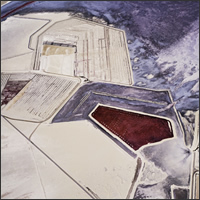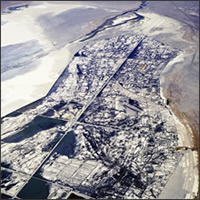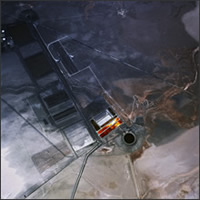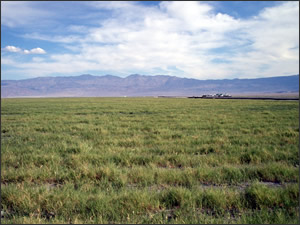Contact EPA Pacific Southwest Air Program
Pacific Southwest, Region 9
Serving: Arizona, California, Hawaii, Nevada, Pacific Islands, Tribal Nations
Air Actions, California
Owens Valley Particulate Matter Plan
Contact
Larry A. Biland (biland.larry@epa.gov)
U.S. EPA Region 9
Owens Lake Federal Project Manager
(415) 947-4132
People find inspiration in all sorts of places. Owens Lake is a fine example ... by 1930, the once vibrant lake was a barren patch of earth. Dry and dusty, it had been drained to slake the thirst of a growing Los Angeles. Because of the make-up of the lake bed and the winds in the area, the area around Owens Dry Lake Bed became a dust bowl, with clouds containing particulate matter, cadmium, chromium, chlorine and iron getting kicked up on a regular basis.
Today, clean air is on the horizon. On November 17, 2001, the Los Angeles Department of Water and Power (LADWP), began irrigating the dust-prone lake bed to reduce dust storms. The new landscape the irrigation is giving birth to has proved to be an artistic inspiration for photographer David Maisel, who first photographed the lake and its recovery on Sept. 5 and 6, 2001. Maisel’s work is now available in a book entitled “David Maisel: The Lake Project” and a few samples are shown here.



Courtesy of David Maisel



The U.S. EPA became involved in the Owens Valley air pollution issue in the 1990s, encouraging Los Angeles and the local Great Basin Air Pollution Control District to develop a plan for the lake bed. In 1999 they reached an agreement to bring the valley’s air quality up to the national health standard by 2006. For generations before this agreement, dust rising each winter from the dry, windy bed of Owens Lake has created the nation’s worst particulate air pollution problem.
When it was “discovered” in 1845 by California pioneer John Fremont and his party, Owens Lake and the valley and mountains surrounding it was a prominent feature on the landscape of the eastern Sierra. Until the early part of the last century, the saline lake covered about 100 square miles and was as much as 30 feet deep in places. During 2000 and 2001, the LADWP built a network of pipes and irrigation “bubblers” (outlets) on 10 square miles of the lakebed. The network was expanded in 2002 and 2003. By the time the $415 million, L.A.–funded project is finished, the air should be safe to breathe year–round for the first time in over 70 years.
EPA also worked with the state Air Resources Board, local air agency, tribes, and the city of Los Angeles to update a dust control (PM10) plan for rural Owens Valley, east of the southern Sierra Nevada. For decades, the valley had been plagued by dust storms rising from the dry Owens Lake bed that gave it the nation's worst PM10 problem. EPA helped bring together the valley's government agencies, tribes, and the LADWP (still the owner of most of the valley's water rights) to hammer out a plan to curtail the dust storms by re-flooding and planting salt-tolerant grasses on 29.8 square miles of the dry lake bed.
Maisel’s photographs are an abstraction of an ecosystem that underwent an extreme environmental change that is now, with help, being transformed into something less of aberration.
